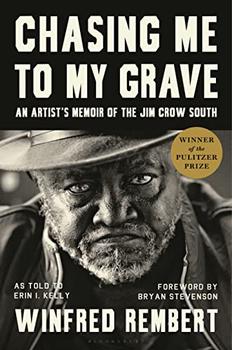Summary | Excerpt | Reviews | Beyond the book | Read-Alikes | Genres & Themes | Author Bio

An Artist's Memoir of the Jim Crow South
by Winfred RembertChasing Me to My Grave might be the most authentic, vulnerable autobiography you'll ever read. Artist Winfred Rembert holds nothing back in recounting his life, reviewing all of its beauty and hardship. The good, the bad and the unambiguously ugly details provide insight into the forces that shaped Rembert's art, and his amazing story offers a holistic and refreshing approach to discussing racism that is extremely compelling.
Rembert (who passed away in March 2021) lived during tumultuous times. Born in Cuthbert, Georgia in 1945 and raised on a cotton plantation, his early years were filled with terrifying and traumatizing racist episodes that chased him through the rest of his life. At 19 he was arrested for grand theft auto after fleeing white men with shotguns at a civil rights rally. He escaped jail by beating up a police officer and locking him in a cell. When he was caught, he was nearly lynched, but survived purely through luck.
This was followed by a seven-year stint in prison where he was forced to work on a chain gang — an excerpt of this harrowing chapter is available from the New Yorker. One day, while working on the chain gang, he saw the woman who would be the love of his life, Patsy, in her front yard. The two struck up a conversation and began corresponding while Rembert was still in prison. They married after he was released, and Patsy served as Winfred's anchor throughout the rest of his life, encouraging and inspiring him in his artistic endeavors.
It was in prison that Rembert first learned to paint on leather — an art form he later perfected and became famous for. He fled Georgia and the overt racism of the Deep South for Bridgeport, Connecticut, but he struggled financially once he arrived. He worked as a longshoreman but was not permitted to join the union and therefore couldn't work full-time. He then suffered a debilitating hernia and had to leave the job entirely.
Rembert and Patsy started building a family, and he became wealthy working for a drug gang. However, he was not very good at disguising his newfound affluence and he attracted attention from law enforcement. He was arrested and sent back to prison. Throughout it all, Patsy stayed with him and encouraged him to tell his story through art. Finally, in the early 2000s, when Rembert was in his 50s and no longer in prison, his work caught on locally in Connecticut, and after a show at Yale University he achieved national acclaim.
Rembert was undoubtedly a victim of American systemic racism. Yet, this book is not about victimization. Rather, like his incredible art, which is highlighted at wonderful intervals throughout and appears in the excerpt, his memoir combines all of the most emotionally powerful moments in his life, leaving us with the impression of a person who is grateful for what he achieved with the deck stacked against him. He comes off as downright gracious for a man who ran from racism and fear of violence his whole life.
This book was co-written with journalist Erin I. Kelly, who sat down with Winfred every two weeks from 2018 through 2020 and transcribed his memories from biographical interview questions. She then read the pages back to him to make sure she had captured his voice accurately. The result is a masterpiece. The text is raw, candid and blunt. Kelly's organization and faithful transcription allow Rembert's stories to roll off the page as fluidly as they likely did from his mouth. This combination of armchair storytelling with fascinating life events makes Chasing Me to My Grave a compulsive read.
Rembert was not a perfect man, but this memoir shines because he doesn't try to hide his personal failures and demons. Both ubiquitous racism and the consequences of his own actions in trying to outrun the system itself chased him to his grave. But he left us with his indelible art and this remarkable account of his experience, preserved for posterity.
![]() This review was originally published in The BookBrowse Review in October 2021, and has been updated for the
October 2023 edition.
Click here to go to this issue.
This review was originally published in The BookBrowse Review in October 2021, and has been updated for the
October 2023 edition.
Click here to go to this issue.

If you liked Chasing Me to My Grave, try these:

by Kellie Carter Jackson
Published 2025
A radical reframing of the past and present of Black resistance—both nonviolent and violent—to white supremacy.

by Wright Thompson
Published 2025
A shocking and revelatory account of the murder of Emmett Till that lays bare how forces from around the world converged on the Mississippi Delta in the long lead-up to the crime, and how the truth was erased for so long.
These are not books, lumps of lifeless paper, but minds alive on the shelves
Click Here to find out who said this, as well as discovering other famous literary quotes!
Your guide toexceptional books
BookBrowse seeks out and recommends the best in contemporary fiction and nonfiction—books that not only engage and entertain but also deepen our understanding of ourselves and the world around us.